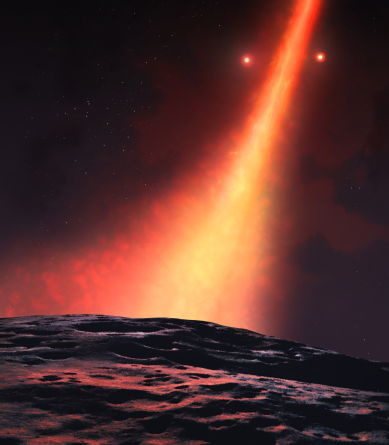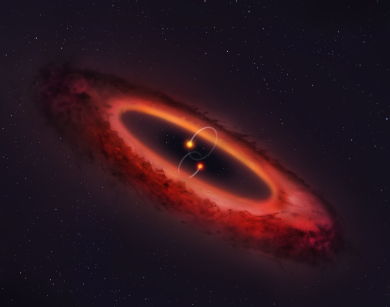It looks like you're using an Ad Blocker.
Please white-list or disable AboveTopSecret.com in your ad-blocking tool.
Thank you.
Some features of ATS will be disabled while you continue to use an ad-blocker.
17
share:
A team of astronomers using the Atacama Large Millimeter Array have found the first double star system that has flipped its stellar disk to a
"position that leaps over the orbital plane of those stars" , the discovery proves a theory that such double star system configurations should
exist.
Artists impression of how the system would look.
The team led by Dr Grant M. Kennedy of the University of Warwick also found some of the same signatures that are associated with planet formation so planets which orbit both stars could exist there and any lifeforms either living there or visiting would have a pretty spectacular view.
Artists impression of the view from an orbiting planet with the stars transiting the disk.

Artists impression of how the system would look.
“Discs rich in gas and dust are seen around nearly all young stars, and we know that at least a third of the ones orbiting single stars form planets. Some of these planets end up being misaligned with the spin of the star, so we’ve been wondering whether a similar thing might be possible for circumbinary planets. A quirk of the dynamics means that a so-called polar misalignment should be possible, but until now we had no evidence of misaligned discs in which these planets might form.”
The team led by Dr Grant M. Kennedy of the University of Warwick also found some of the same signatures that are associated with planet formation so planets which orbit both stars could exist there and any lifeforms either living there or visiting would have a pretty spectacular view.
If there were a planet or planetoid present at the inner edge of the dust ring, the ring itself would appear from the surface as a broad band rising almost perpendicularly from the horizon. The polar configuration means that the stars would appear to move in and out of the disc plane, giving objects two shadows at times. Seasons on planets in such systems would also be different. On Earth they vary throughout the year as we orbit the Sun. A polar circumbinary planet would have seasons that also vary as different latitudes receive more or less illumination throughout the binary orbit.
Co-author Dr Daniel Price of Monash University’s Centre for Astrophysics (MoCA) and School of Physics and Astronomy added: “We used to think other solar systems would form just like ours, with the planets all orbiting in the same direction around a single sun. But with the new images we see a swirling disc of gas and dust orbiting around two stars. It was quite surprising to also find that that disc orbits at right angles to the orbit of the two stars. “Incredibly, two more stars were seen orbiting that disc. So if planets were born here there would be four suns in the sky!
warwick.ac.uk...
Artists impression of the view from an orbiting planet with the stars transiting the disk.

It almost appears it is some sort of living production cell. I am not sure our definition of life is adequate enough to be relevant. I would bet
that thing contains all the necessary chemistry and elements to form life, sort of like something growing. Life is just structured chemical reactions
which include a program, DNA/RNA, to form. What if there is a much broader spectrum to life. Just because man defined the parameters of life doesn't
mean the definition is more than an opinion.
Makes me think of our own sun and how it is 6 degrees off the ecliptic plane. Something is pulling on it from somewhere. People are looking for it.
a reply to: gortex
Fantastic! I like the artist impressions. I then decided the artist's impressions are probably far removed from the awesomeness of the birth of a new solar system. Puts me in mind of the flower of life and sacred geometry
Fantastic! I like the artist impressions. I then decided the artist's impressions are probably far removed from the awesomeness of the birth of a new solar system. Puts me in mind of the flower of life and sacred geometry
..contains the patterns of creation as they emerged from the "Great Void". www.bibliotecapleyades.net...
originally posted by: teapot
I then decided the artist's impressions are probably far removed from the awesomeness of the birth of a new solar system.
Yeah, but in the reverse. If you were in a little rocket ship actually looking at it with your eyeballs, it probably wouldn't look like anything. Space is really really big. Planets are small.
a reply to: gortex
So... what "moved"? It almost sounds like they're saying the entire planetary accretion disk rotated 90 degrees (in relation to the host stars). For some reason it makes more sense in my mind that it is the orbit of the sun's which gradually shifted over time (and will likely continue to shift, and another million years in the future they might be aligned with their accretion disc. Is it disc or disk?) to it's current orientation. This shift would seem to cause some disturbances in the accretion disk, but overall it apparently kept its shape, according to artist recreation of the moment for broadcast purposes.
So... what "moved"? It almost sounds like they're saying the entire planetary accretion disk rotated 90 degrees (in relation to the host stars). For some reason it makes more sense in my mind that it is the orbit of the sun's which gradually shifted over time (and will likely continue to shift, and another million years in the future they might be aligned with their accretion disc. Is it disc or disk?) to it's current orientation. This shift would seem to cause some disturbances in the accretion disk, but overall it apparently kept its shape, according to artist recreation of the moment for broadcast purposes.
new topics
-
D.B. Cooper mystery may be solved
General Conspiracies: 4 hours ago
top topics
-
D.B. Cooper mystery may be solved
General Conspiracies: 4 hours ago, 13 flags
17

